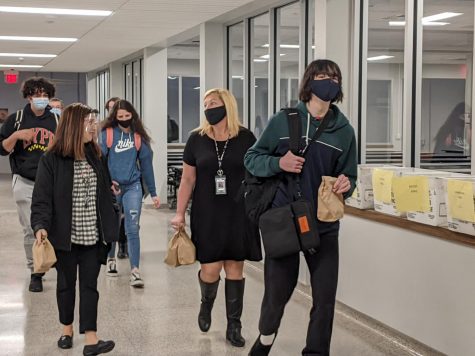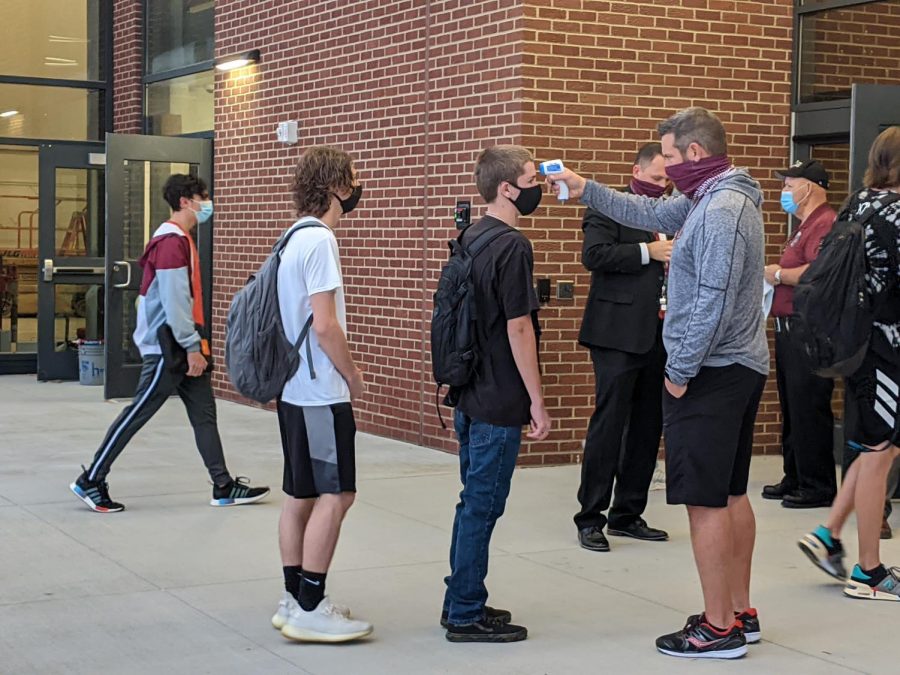Back to school. Students and teachers return to the school in-person for the first time in months. Students’ temperatures are checked everyday when they come into the building. Although students and teachers share a hybrid schedule, teachers physically go to the school everyday of the week, unlike the students who spend half of the week virtually.
Teachers voice concerns, frustrations with new hybrid schedule
November 18, 2020
During these times of uncertainty, teachers are faced with unfamiliar challenges and struggles with the new hybrid schedule, something that over time they must learn to solve–but time is what they don’t have.
The hybrid schedule splits students into two groups: A and B. The groups are divided by last names, placed into alphabetical order.
Monday, Nov. 16, was the first day of the hybrid schedule. Group A students attended physically while Group B students remained virtual (and this rotates throughout the week; Group B students attended physically the following day).
This new and sudden change has affected teachers in many different ways. For most, technology has been a constant challenge, especially when taking attendance, something that can be overwhelming to track.
“We have been meeting on Google Meets, so I can have access to the students every day. I have to have a different seating chart for nearly every day of the week for each class,” English teacher Amy Martin said.
Alongside issues with attendance and technology, teachers struggle with teaching both online and in-person students simultaneously.
“It’s been challenging to try and get everyone at home and here in class to do the same thing. A lot of times I have issues with Google Meets or I can’t see the chat–there are just so many different issues to try and get everybody to be in the same place at the same time,” science teacher Heather Partsch said.
With the split in classes, teachers find it difficult to communicate with their students.
“I’m challenged with keeping students engaged, because some students do work better with a teacher in-person, and it’s hard to gauge if they are doing well with an assignment at home. A lot of times they [virtual students] sit there and don’t say anything,” physics teacher Jeremy Rupeka said.
Everything from issues with microphones, iPads, Chromebooks, students being able to view the classroom boards virtually, feedback during Google Meets, poor Wi-Fi connections and general lack of communication are just a handful of the problems teachers encounter within one class period.
As with class periods, the length of each period has been lessened this year due to the new eight period class schedule, meaning the amount of time teachers have to fix these problems is also shortened, only adding to the stress of hybrid teaching.
Because of this, many teachers have to cut out certain lessons or assignments they would usually do with their students.
“Assignments are modified and shortened from what we normally would do. There’s less practice since we are losing eight minutes every day compared to last year. We’re obviously not going to be able to do the same amount of things we did last year,” Rupeka said.
For Rupeka, students won’t take part in the roller coaster project–traditionally one of the biggest projects of the year.
“For the roller coaster project, we [the physics team] already decided that we are scrapping it this year. We’re not doing them because we can’t really tell them to go into another person’s home. With COVID and everything going on and if students are quarantined–it’s too much. We’re just going to skip it this year and hopefully we can do it next year,” Rupeka said.
Rupeka also had to remove other physics lessons such as graphing vectors since teaching that subject over virtual with the hybrid format is too difficult.
Some teachers fear that with less time, students won’t receive the same quality of lessons as prior students have.
“It’s less time for classes which is very, very difficult. Especially since, after a year that we’re behind, now we’re even more behind. We’re not even getting through half of the material that we should be. If we go back to asynch and synch, we’ll maybe get through one third of the material that we normally do by the end of the year,” French teacher Veronica Skomra said.
Despite these challenges, teachers have found certain methods of teaching that work best for them. Some teach a mini-lesson each day while some hand out the work digitally.
“Everything is digital now. There is no point in me passing out papers to the students that are here because the people at home aren’t getting the papers anyway. I just post [assignments] for everybody and students keep doing what they would do as if they were home anyway. The only difference is I’m here, and the students that are here with me are able to actually ask me in-person instead of being online. It’s still the same idea,” Skomra said.
Partsch, like many teachers, uses Google Classroom as a main resource for both students who attend virtually and physically.

Students and teachers walk through the hallways together on the first day of returning back to school. Everyone at the school is required to wear masks at all times and encouraged to social distance as much as possible. (Wanda Vanish)
“I’m using Google Classroom to push everything out. So whether you’re in class or you’re at home, you’re getting the same worksheets, materials, etc. If I’m teaching something new, I make sure that the students at home get to see me teaching it on Google Meets as well,” Partsch said.
While some rely on Google Classroom or other websites, Martin uses Google Meets and her Chromebook to communicate and make sure everyone–both virtual and physical students–is learning at the same pace.
“I have been just using the Chromebook, and the Chromebook goes where I go. So if I’m talking, the Chromebook is with me. I’ve been trying to operate on a system of doing the teaching up front [in class] and then give a little time to work and ask questions, and I go around the room for that or check the chat for anyone at home,” Martin said.
Martin teaches a mini-lesson for her students each day both virtually and in-person. However, assignments that would usually take a day now take two or more, yet Martin is still confident in her teaching and in her students.
“I think what I’m doing for the students and what they are getting is every bit as good as what I’ve done before,” Martin said.
Despite all these concerns and frustrations, teachers are glad to see students again and be able to communicate in-person, something teachers and students lacked during virtual learning. However, with the happiness of seeing students again comes the safety concerns and precautions that must be taken because of the pandemic.
“I love seeing the kids again. I think [in-person learning] just works so much better for a lot of people. If you’re not strong with written language and all of your directions are in writing–it kind of throws the students. I like that we are able to see the students and able to clarify pretty quickly in person. However, we are in a pandemic. I think when we were in remote, we were keeping our community safe. So this is a little riskier,” Martin said.
“Because I’m concerned about getting COVID, I do feel comfortable being virtual in terms of my own health, but I know that being in-person really helps the students. I’m really big with trying to make sure I have a good rapport with my students, and it’s really hard to get that rapport virtually. I’m glad to be with them now though and build some of that rapport,” Partsch said.
Teachers and students are working to get back into routine with the eight period day and try to stay positive during these times.
“I love that we’re back. It’s a slow start for me, and I feel like I have no teaching stamina. I’m like, ‘I’m exhausted!’ It is nice though to be able to get back and even in working with the small groups it feels better to be back in the classroom. I feel like it was a good decision by the school to split into groups because I would have had a couple classes with 26 people in here, and that’s a lot,” Martin said.
With everything going on, teachers ask students to be patient and understanding.
No matter the positives and negatives of hybrid learning, the hybrid schedule is a temporary decision from the school board made at a special meeting at the beginning of November.
“If cases continue to increase, I think, logistically, we’ll have so many students and teachers quarantining that it’s just not going to be feasible to stay in school,” Partsch said.
Some teachers have even prepared for a shut-down, like Martin who is ready if anything happens.
“I take everything home every night just in case. That way I’m ready and can meet with my students and do what I need to if things change on a dime,” Martin said.

kamika helsel • Jan 8, 2021 at 9:07 pm
this is such a well put together story, syd! LOVED it!